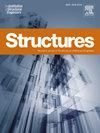基于高斯过程的工程结构动态可靠性评估方法
IF 4.3
2区 工程技术
Q1 ENGINEERING, CIVIL
引用次数: 0
摘要
针对随机动力荷载作用下的工程结构系统,提出了一种基于主动学习高斯过程(GP)的动态可靠性评估方法。该方法采用结构响应极值分布的评价来表示某一时间段内的动态可靠度水平。利用GP模型建立了影响因素与结构输出响应之间的强非线性关系。在此基础上,提出了一种主动学习策略,该策略包括一种称为6σ-β采样域的最优采样域定位方法和一种用于选择最佳样本的新学习函数RIGS(x)。所提出的主动学习策略使所构建的GP模型能够高效、准确地逼近结构的复杂失效极限状态函数,并实现GP模型的自适应更新。通过数值算例和对“雪龙2号”极地船起重机结构可靠性的评估,验证了所提方法的适用性和有效性,并将结果与其他方法进行了比较。该方法通过集成智能采样策略和自适应建模技术,实现了动态可靠性分析计算效率和精度的协同优化。本文章由计算机程序翻译,如有差异,请以英文原文为准。
Dynamic reliability assessment method based on Gaussian process for engineering structures
This study presents a novel dynamic reliability assessment method based on active learning Gaussian processes (GP), designed for engineering structural systems subjected to random dynamic loads. In this method, the evaluation of the extreme value distribution of structural responses is used to represent the dynamic reliability level over a specific time period. The GP model is used to establish a strong nonlinear relationship between the influencing factors and output responses of the structure. Furthermore, an active learning strategy is proposed, which includes an optimal sampling domain localization method called 6σ-β sampling domain and a new learning function RIGS(x) for selecting the best samples. The proposed active learning strategy enables the constructed GP model to efficiently and accurately approximate the complex failure limit state function of the structure, and achieve adaptive update of the GP model. Numerical examples and the structural reliability assessment of the crane mounted on the Xuelong 2 polar ship are used to verify the applicability and effectiveness of the proposed method, and the results are compared with other approaches. The proposed method achieves a synergistic optimization of computational efficiency and accuracy in dynamic reliability analysis through the integrated use of intelligent sampling strategies and adaptive modeling techniques.
求助全文
通过发布文献求助,成功后即可免费获取论文全文。
去求助
来源期刊

Structures
Engineering-Architecture
CiteScore
5.70
自引率
17.10%
发文量
1187
期刊介绍:
Structures aims to publish internationally-leading research across the full breadth of structural engineering. Papers for Structures are particularly welcome in which high-quality research will benefit from wide readership of academics and practitioners such that not only high citation rates but also tangible industrial-related pathways to impact are achieved.
 求助内容:
求助内容: 应助结果提醒方式:
应助结果提醒方式:


